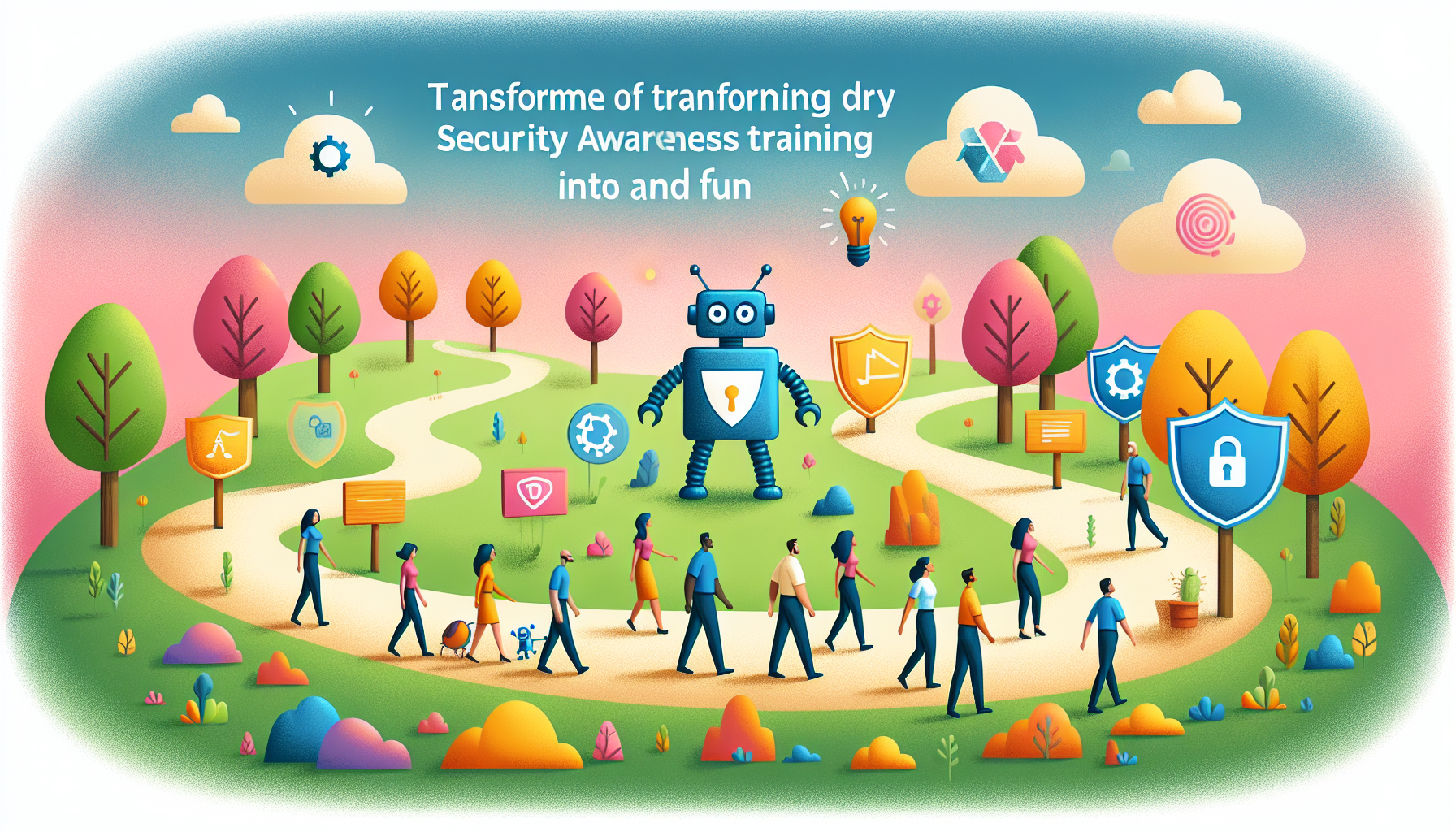We all know that security awareness training can feel a bit dry and overwhelming, right? With ever-evolving cyber threats, it’s tough to keep up without feeling like you’re drowning in jargon and policies. You’re definitely not alone in this!
But what if I told you that there’s a creative way to breathe life into your training sessions? Stick around, and I’ll share how using ChatGPT prompts can transform your security awareness efforts into engaging and effective experiences for everyone involved.
From tackling phishing schemes to ensuring password safety, we’ll explore a range of prompts that make learning fun and relatable. Let’s unlock the potential of ChatGPT together and make security awareness training a breeze!
Key Takeaways
- Security awareness training is essential for protecting against cyber threats.
- Using ChatGPT prompts can make training more engaging and relatable for employees.
- Create scenario-based prompts to encourage critical thinking and real-world application.
- Focus on clear language for better understanding across all employee levels.
- Include topics like phishing, password security, and social engineering for comprehensive training.
- Assess training needs to fill knowledge gaps and enhance overall security awareness.

Effective ChatGPT Prompts for Security Awareness Training
Security awareness training is crucial for protecting organizations from cyber threats.
Using ChatGPT, you can create engaging and effective training prompts that enhance employee awareness.
Here are some prompts that can get you started:
- “List five common cybersecurity threats employees should be aware of in the workplace.”
- “Explain the importance of security awareness training in fostering a safe work environment.”
- “Create a checklist for employees to recognize and avoid phishing scams.”
- “Describe the potential consequences of a data breach for the company and its employees.”
- “Generate a scenario where an employee encounters a cybersecurity threat and explain how to handle it.”
Tips for Creating Your Own Security Awareness Prompts
Creating effective prompts for security awareness training is all about clarity and engagement.
Start by identifying the specific security topics relevant to your organization.
Here are some tips to guide you in crafting your own prompts:
- “Make prompts scenario-based to encourage critical thinking among employees.”
- “Use straightforward language to ensure comprehension across all employee levels.”
- “Tailor prompts to reflect your organization’s specific security policies and procedures.”
- “Encourage employee participation by framing prompts as questions they might encounter in real life.”
- “Assess the training needs of your team before creating prompts to fill in knowledge gaps.”
Examples of ChatGPT Prompts for Phishing Awareness
Phishing is one of the most common tactics used by cybercriminals.
Using ChatGPT, you can craft effective prompts to help employees recognize and respond to potential phishing attempts.
Here are some practical prompt examples:
- “Provide examples of phishing email subject lines that should raise suspicion.”
- “Describe the steps an employee should take if they think they’ve received a phishing email.”
- “Identify the signs of a phishing website and how to verify a site’s legitimacy.”
- “Simulate a phishing email scenario and ask employees to respond with how they would report it.”
- “List common tactics used in phishing attacks and how to avoid falling for them.”
ChatGPT Prompts for Password Security Best Practices
Password security is vital in maintaining organizational security.
Here are some ChatGPT prompts you can use to enhance your team’s understanding of password hygiene:
- “What are the characteristics of a strong password? Provide examples.”
- “Explain the differences between password managers and traditional password storage methods.”
- “Discuss the importance of multi-factor authentication and when to use it.”
- “List common password mistakes employees make and how to avoid them.”
- “Create a step-by-step guide for resetting a forgotten password safely.”
For further reading on enhancing educational tools with ChatGPT, check out our post on ChatGPT for Education.
Interested in boosting creativity alongside security training? Explore prompts aimed at creative writing.

Prompts for Teaching Employees About Social Engineering
Social engineering relies on manipulation to exploit human psychology.
ChatGPT can help design prompts that arm your employees with the knowledge to identify and counter these tactics.
- “Explain what social engineering is and provide three real-world examples of how it has been used.”
- “Identify common psychological tricks used in social engineering and how to recognize them.”
- “Create a scenario where an employee is approached by someone requesting sensitive information and describe how they should respond.”
- “List signs that indicate an email or call may be a social engineering attempt.”
- “Simulate a conversation where an employee must identify a social engineering ploy and explain their thought process.”
Using ChatGPT to Create Scenario-Based Learning Prompts
Scenario-based learning engages employees by placing them in realistic situations.
Using ChatGPT, you can craft prompts that challenge them to think on their feet and apply their security knowledge.
- “Develop a scenario where an employee receives a suspicious message claiming to be from IT. What should they do?”
- “Create a prompt for a role-play where two employees simulate a social engineering attack and a defense strategy.”
- “Simulate an incident where confidential information is shared inadvertently. How should the employee handle the aftermath?”
- “Craft a series of decision points in a cybersecurity incident scenario, asking employees to choose the best course of action.”
- “Describe a realistic data breach situation and ask employees to outline steps to prevent future incidents.”

Prompts for Discussing Data Protection and Privacy
Data protection and privacy are essential topics that every employee should understand.
Using ChatGPT, you can create prompts that clarify these concepts and encourage compliance.
- “Explain the key principles of data protection and why they matter to our organization.”
- “Describe the steps employees should take to protect personal data in their daily work.”
- “List common data privacy regulations (like GDPR) that our employees should be aware of.”
- “Simulate a scenario where an employee accidentally shares private information. How should they respond?”
- “Create a checklist for employees to assess their own data protection practices.”
How to Use ChatGPT for Cybersecurity Policy Reviews
Using ChatGPT to review cybersecurity policies can streamline the process and ensure clarity.
Follow these steps to effectively utilize ChatGPT in your policy reviews:
- “Input your current cybersecurity policies and ask ChatGPT to summarize key points and suggest improvements.”
- “Request a list of common gaps in cybersecurity policies that organizations often overlook.”
- “Develop prompts to ask employees how well they understand existing policies and where they see room for clarification.”
- “Use ChatGPT to generate examples of real-world incidents that align with your policies, enhancing relevance.”
- “Ask for feedback prompts that can evaluate employee awareness of policy changes after revisions.”
Prompts for Engaging Employees in Security Workshops
Engaging employees in security workshops can be a game-changer for fostering a culture of security.
Here are some prompts to keep the conversation going:
- “Create interactive scenarios for employees to role-play incident responses during the workshop.”
- “Suggest group activities that can educate employees about recognizing security threats together.”
- “Design a quiz that allows employees to test their cybersecurity knowledge in a competitive format.”
- “Ask employees to share their personal experiences with security threats and how they managed them.”
- “Encourage discussion by asking what security tools or practices employees feel would benefit the organization.”
Evaluating the Effectiveness of Security Awareness Training Prompts
Evaluating the effectiveness of your security awareness training is key to continuous improvement.
Here’s how you can measure training success:
- “Develop a feedback survey for employees to express their grasp of security concepts learned.”
- “Create a follow-up quiz to assess retention of knowledge gained during the training.”
- “Ask ChatGPT to provide best practices for measuring training outcomes and adapt them to your context.”
- “Analyze incident reports before and after training to see any changes in employee behavior regarding security.”
- “Compile key performance indicators (KPIs) to track improvements in employee security practices over time.”
FAQs
Effective prompts should be specific, scenario-based, and relevant to the audience. Examples include role-playing phishing attacks, discussing password security, and real-world social engineering cases to actively engage employees in learning.
To create your own prompts, identify key security topics, tailor scenarios to your organization, and encourage interactive discussion. Use specific circumstances that employees might encounter to enhance relatability and engagement.
Scenarios can include simulated phishing emails, identifying suspicious links, and recognizing social engineering tactics in phone calls. These realistic situations help employees practice their responses and enhance their vigilance against actual phishing attempts.
Evaluate effectiveness by conducting pre- and post-training assessments, gathering feedback, and observing employee behavior changes. Metrics such as incident reports and phishing test results can also provide insights into training impact.
